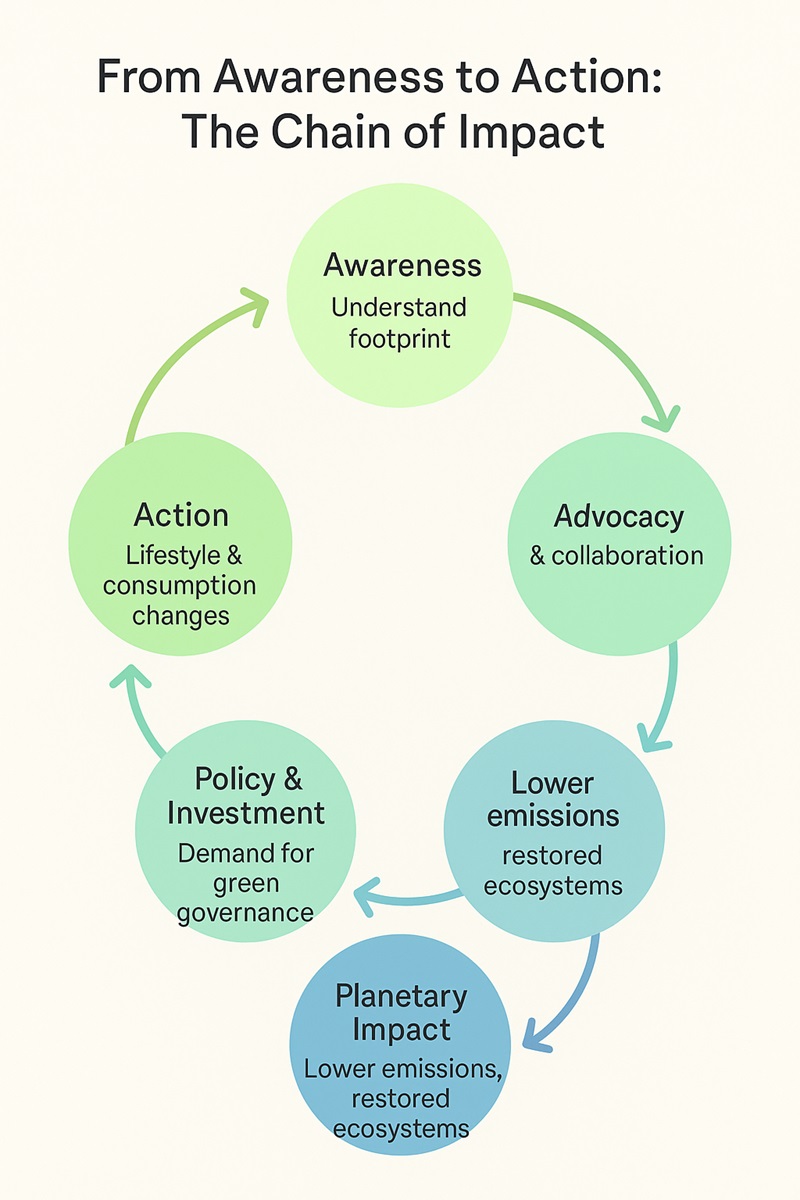Taking action for the planet has never been more urgent—or more achievable. Every choice you make, from the food you eat to the power that fuels your home, shapes the health of our shared environment. With the planet entering its hottest years on record and ecosystems under immense strain, individual and collective responsibility matter more than ever.
This guide outlines seven proven, science-backed ways to reduce your ecological footprint, support healthier communities, and align your daily life with a sustainable future.
Why Awareness Matters in 2025
The year 2024 officially became the hottest year ever recorded, with global temperatures about 1.6 °C above pre-industrial levels, according to the World Meteorological Organization (WMO). That heat drove record wildfires across Canada, Brazil, and Southern Europe, while floods and droughts intensified on nearly every continent.
At the same time:
- Roughly 10.9 million ha of forest are still lost each year (FAO 2025), much of it to industrial agriculture.
- Over 2 billion people remain without safe drinking water, and UN Water projects a 40 % global water shortfall by 2030.
- Plastic waste continues to choke oceans—if unchecked, plastics could outweigh fish by 2050 (UNEP).
These facts illustrate one truth: awareness drives action. Understanding the footprint of your daily habits is the first step toward meaningful change.

The Global Snapshot: Our Planet in 2025
To see how personal actions matter, it helps to understand the bigger picture.
The world has made real progress in clean energy and conservation — but our overall impact on nature is still huge.
Key Global Indicators
| Indicator | 2015 | 2024 | 2025 Trend | Source |
| Global CO₂ Emissions | 36.2 Gt | 37.4 Gt | Slight decline after record high | WMO, IEA 2025 |
| Forest Loss (annual) | 11.5 M ha | 10.9 M ha | Stable, but wildfires rising | FAO SOFO 2025 |
| Renewable Power Share | 24% | 31% | Fast growth led by solar and wind | IEA Renewables 2025 |
| Plastic Waste Generated | 260 Mt | 350 Mt | Still increasing | UNEP Plastics Outlook 2025 |
| Water Stress Index | — | 2B people lack safe water | Severe in South Asia, MENA | UN Water 2025 |
These numbers show both hope and warning signs.
Clean energy is growing fast — but waste, water stress, and deforestation remain serious challenges.
Bridging these gaps will take individual and community action — the kind of steps shared in the seven strategies below.
1. Cut Your Carbon Footprint at Home
Energy use in households accounts for nearly 20 % of global CO₂ emissions.
Simple changes can deliver measurable impact:
- Replace old bulbs with LED lighting (uses 75 % less energy).
- Install smart thermostats or energy-monitoring plugs.
- Choose renewable-energy suppliers where possible or explore community solar.
- Unplug idle electronics—“vampire power” can waste up to 10 % of household electricity.
Tip: The U.S. DOE and the EU Energy Agency both provide free calculators to track home-energy savings.
2. Travel Smarter
Transportation remains a top emissions source.
To reduce it:
- Walk, cycle, or use public transit for short distances.
- Carpool or join local EV-sharing programs.
- For longer trips, favor train over plane when viable.
- Offset unavoidable flights using verified carbon-credit programs (Gold Standard, Verra).
Each avoided 100 km of car travel saves roughly 20 kg CO₂e—small numbers that multiply fast.
3. Eat for the Planet
Our diets shape both health and habitat.
Research from Oxford University (2024) shows that adopting a primarily plant-based diet can cut food-related emissions by 60 %.
Try:
- Reducing red-meat meals to once a week or less.
- Choosing local, seasonal produce to shrink transport emissions.
- Limiting food waste through composting and meal planning.
Every meal that swaps beef for beans saves about 30 kg CO₂e—the emissions of driving 75 miles.
4. Embrace Sustainable Technology
Technology is rapidly transforming how we live—and it can advance sustainability when used thoughtfully.
- Smart homes optimize lighting, heating, and cooling.
- Electric vehicles (EVs) and battery storage cut fossil-fuel reliance.
- Precision agriculture helps farmers reduce water and fertilizer waste.
- Even in personal care, durable-use innovations—for example, energy-efficient skincare devices Pure impact by Sofwave system—illustrate how design longevity reduces material waste.
Pair high-tech with mindful consumption: choose products built to last, not to replace.
5. Support Nature’s Recovery
It’s not enough to reduce harm — we must also help the Earth heal.
In 2025, deforestation and wildfires grew again, setting back global climate goals.
You can make a real difference by:
• Donating to or volunteering with tree-planting and wetland-restoration groups.
• Planting native trees or small gardens for bees and butterflies.
• Buying products from sustainable farms or eco-friendly forestry programs.
Every restored hectare can absorb up to 12 tons of CO₂ each year while protecting animals, plants, and clean water.
Economic and Policy Drivers Behind the Change
Real progress for the planet depends not only on personal action — but also on smart policies and green investment.
In 2025, new global efforts are reshaping how the economy and environment work together.
Key Shifts Driving Change
- Carbon Pricing Grows
Today, more than 25% of global emissions are covered by carbon pricing or trading systems.
These programs make pollution costly, pushing industries to cut carbon and adopt cleaner methods. - Major Green Laws Expand
The EU Green Deal and the U.S. Inflation Reduction Act continue to fuel billions in clean energy, home retrofits, and electric vehicle incentives.
These laws are speeding up the shift to renewable power and energy-efficient living. - Climate Aid for Vulnerable Nations
The Loss and Damage Fund, created at COP 28 and financed through 2024–2025, now helps countries hit hardest by climate disasters.
It supports rebuilding, adaptation, and protection from extreme events. - Rise of Green Finance
The World Economic Forum (2025) estimates that sustainable investments now total $9–30 trillion worldwide.
Investors are rewarding companies that lower emissions and act responsibly.
These changes create a positive cycle:
As consumers demand greener choices, businesses innovate, and governments strengthen policies.
Together, they make sustainability not just an ideal — but the new standard for global growth.
6. Get Involved in Your Community
Change grows faster when people act together.
Join or start local projects like:
• Neighborhood clean-ups and recycling drives
• Community gardens or compost programs
• Efforts to promote renewable energy and walkable cities
Community action and voting have far more power than acting alone.
Be part of local meetings, speak up, and hold leaders responsible — your voice can spark system-wide change.
7. Track and Celebrate Your Progress
You can’t improve what you don’t measure.
Use free tools like the UN Carbon Footprint Calculator, JouleBug, or My Green Lab to track your energy, water, and waste habits.
Set small monthly goals — like cutting a few kilowatts, saving liters of water, or recycling more.
Share your results with friends or local groups to stay motivated.
Being open about your progress turns small steps into strong, lasting habits.
Myth vs. Fact: Clearing Up Common Sustainability Misunderstandings
Knowing the truth about sustainability helps people make smarter choices for the planet and their wallets.
Here are a few common myths — and the real facts behind them.
| Myth | Fact (Simplified for Clarity) |
| “Recycling always saves energy.” | Only when materials are clean and sorted correctly. Dirty plastics can use more energy than they save (UNEP 2024). |
| “Electric cars pollute more than gas cars.” | Not true. Over time, EVs produce 50–70% less CO₂, even after counting battery production (IEA 2024). |
| “Individual actions don’t make a difference.” | They do! If just 10% of homes made energy upgrades, global CO₂ could drop by 1 gigaton every year (IPCC AR6). |
| “Paper is always greener than plastic.” | Not always. Making paper uses more water. Reusable items are the best choice for the planet. |
| “Eco-friendly products cost more.” | Often the opposite. Energy-efficient goods can save 15–30% in five years by lowering energy use. |
Real-World Change in Action
Real environmental progress happens when people and leaders work together.
These stories show how small actions and smart planning can create big results.
Dhaka Canal Restoration, Bangladesh
Volunteers joined the #CholoKhaalBachai campaign to clean blocked canals.
Once water flowed again, flooding dropped, and the city’s air became cleaner.
☀️ Masdar’s 24/7 Solar Project, UAE
Masdar built the world’s first solar plant that runs day and night.
It stores sunlight in underground batteries to give clean energy all the time.
Costa Rica’s Forest Comeback
Costa Rica pays landowners to protect trees and restore land.
Since the 1980s, the country has doubled its forest cover.
Now, almost all its electricity comes from clean, renewable energy.
♻️ Portland, Oregon Zero-Waste Program
Portland’s composting and recycling plans kept 70% of waste out of landfills in 2024.
Education programs helped homes and businesses do their part.
Each story shows a simple truth:
Local action creates global change.
Working together brings faster results than waiting for others to lead.
Why This Matters
Clearing up these myths helps everyone — from families to companies — focus on what really works.
When facts guide our choices, sustainability becomes simpler, smarter, and far more effective.

A Global Shift Toward Responsibility
Sustainability is now embedded in mainstream economics.
- Nearly 90 % of major corporations publish ESG (Environmental, Social & Governance) reports (WEF 2025).
- Sustainable-investment assets are projected between $9 – 30 trillion globally.
- Three-quarters of consumers prioritize eco-responsible brands.
Yet emissions must still fall 42 % by 2030 and 57 % by 2035 to meet Paris Accord goals (IPCC AR6).
Progress depends on aligning markets, policies, and personal choices—the three pillars of true sustainability.
The Science of Sustainable Habits
Why do some green habits stick while others fade?
Behavioral science gives simple answers — and practical ways to make change last.
Start Small, Win Big
Replacing just one daily disposable item, like a plastic bottle, boosts the chance of bigger lifestyle changes by 60%.
Small wins build momentum.
Plan Ahead with “If-Then” Goals
Use clear plans like, “If it’s sunny, I’ll bike instead of drive.”
These small mental cues can double your success rate for staying consistent.
Share Your Progress
When people see your progress, it motivates both you and them.
Sharing updates with friends can increase accountability by 30%.
Track Your Impact
Smart meters, eco-apps, or simple dashboards turn your progress into visible results.
Seeing numbers grow makes goals feel real and rewarding.
The Takeaway
When people understand the why behind habits, sustainability becomes part of who they are — not just something they do.
It shifts from a chore to a choice, and finally, to identity.
Your Role in the Collective Journey
You are part of a global movement that values balance over excess.
By choosing renewable power, conserving resources, supporting restoration, and inspiring others, you help drive systemic change.
Sustainability is no longer optional—it’s the pathway to economic resilience, cleaner air and water, and a livable climate for future generations.
Final Thought
Boosting your environmental impact begins with awareness and intention. The choices you make today—small or large—form ripples that build global waves of change.
Live consciously, act collectively, and help make 2025 the year humanity truly turns the tide.




